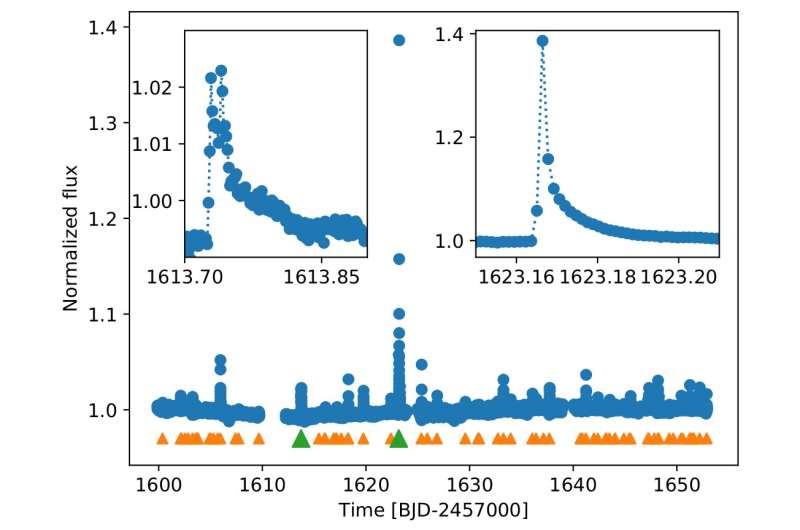Frequent flaring of Proxima Centauri means bad news for its rocky planet

Proxima Centauri is a cool red dwarf with about one-eighth of the sun's mass. Although it is the closest star to the sun, located just 4.2 light-years from the solar system in the triple star system of alpha Centauri, it is not visible to the naked eye. What makes this star particularly interesting is the recent discovery of an Earth-like exoplanet in its habitable zone: a region around the central star where the presence of liquid water is possible on a planetary surface.
Numerical models have shown that Proxima Centauri b probably lost a large amount of its water in its early life stages—an amount comparable to an ocean on Earth—but despite this, it is still possible that some liquid water remained in warmer regions of the planet, maybe in a tropical belt or at the hemisphere facing the central star in case of locked rotation. This makes other factors affecting habitability, such as the magnetic activity of the host star, particularly important, as activity-related phenomena (flares, coronal mass ejections, strong UV flux) can erode a planet's atmosphere, rendering it uninhabitable in the long term.
The strong flaring activity of Proxima Centauri has already been known to astronomers, and several superflares were observed previously. During such eruptions, extremely large amounts of energy are released that may reach 1033 ergs, or 10 times the Carrington event in 1859, the strongest flare ever seen on the sun—consider such a flare from a much smaller star. In 2016, during one these superflares, the brightness of Proxima Centauri increased by a factor of 70 compared to its quiescent state —it became the only cool red dwarf visible to the naked eye, albeit only for a few minutes.
Researchers of the Konkoly Observatory of the MTA CSFK (Budapest, Hungary), led by Krisztián Vida, investigated Proxima Centauri using the newest data from the Transiting Exoplanet Survey Satellite (TESS) space telescope. The primary task of the TESS is to search for Earth-like exoplanets around nearby brighter stars. In its initial two-year mission, it will cover almost the entire sky, spending about a month at each region. TESS observed Proxima Centauri in two sectors between April and June this year.
In the ~50 day-long time series, the researchers identified 72 flares: The star spent about 7 percent of its time flaring. The researchers found signs of oscillations in the light curves of the two largest flares with a time scale of a few hours. These may be due to oscillation of the radiating plasma, or due to periodic reconnections of the magnetic field. The estimated energy of the eruptions was between 1030 and 1032 ergs. These do not reach superflare level, but according to the distribution of the observed events, flares with an energy of 1033 ergs are expected to occur three times a year, while eruptions of one magnitude larger would happen every two years.
Such frequent, high-energy eruptions almost certainly have a severe impact on the atmosphere of Proxima Centauri b: The atmosphere probably cannot relax to a steady state between eruptions, and is continuously altered. This scenario is similar to observations in the TRAPPIST-1 system, another cool red dwarf that hosts exoplanets.
The strong magnetic activity of Proxima Centauri is particularly curious, as strong activity is mainly seen on fast-rotating stars with periods of a few days. In contrast, Proxima Centauri has a rotation period of ~80 days, however, it shows flare activity comparable to the most active fast-rotating objects.
Previous analysis predicted a transit of Proxima Centauri b with a depth of 5 mmag, equal to a 0.5 percent drop in flux—albeit only with a small, 1.5 percent probability. The light curve did not show any clear sign of a transit, although the accuracy of the measurements would allow for its detection.
More information: Flaring activity of Proxima Centauri from TESS observations: quasi-periodic oscillations during flare decay and inferences on the habitability of Proxima b, Astrophysical Journal, arxiv.org/abs/1907.12580
Journal information: Astrophysical Journal
Provided by Konkoly Observatory




















